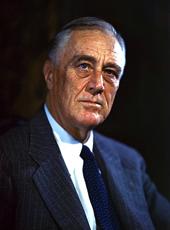
Statement on the Civil Aeronautics Authority Under the New Reorganization Plans.
Since the transmittal of Reorganization Plans Nos. III and IV a flood of misinformation has engulfed those sections dealing with the Civil Aeronautics Authority. Much of this has fallen of its own absurdity and needs no comment. This morning, however, we saw a group of well-intentioned people staking out an exclusive claim to a so-called "lobby to save lives."
The implication that we are not interested in saving lives, which is certainly contradicted by the record of our progress in civil aviation during recent years, compels me to restate in simple terms the basic features of the reorganization plans affecting the Civil Aeronautics Authority.
I might say here that everybody is for the abstract idea of reorganization in the interest of increased efficiency and economy. However, there is a rather discouraging collapse of enthusiasm when concrete proposals are made. In selfish protection of their own special interests we always find particular groups who hitherto favored reorganization arising in protest.
As it now stands, there are three agencies—the Civil Aeronautics five-member Authority, the Administrator, and the Air Safety Board—all autonomous groups, none of them represented at the Cabinet table. The inherent problems confronting them were intensified by friction, particularly within the Air Safety Board. For five months the Administrative Management Division of the Budget Bureau made a study at my request of the operation of the Authority. It became obvious that a change was imperative if we were to continue to move forward in civil aviation. Here, in simple summary, is the proposal:
1. Despite handicaps, the Federal program for civil aeronautics has now achieved a stature and an importance which justify bringing this program more closely into the Federal family. The proposal will place it within the framework of the Department of Commerce where it will have a closer relationship with the important reporting services of the Weather Bureau and the essential air navigation chart service of the Coast and Geodetic Survey. More than that it will provide representation at the Cabinet table for a program of basic significance to our national transportation and our national defense. Present world conditions make the merit of this phase of the proposal obvious.
2. The present five-member Authority which has received such widespread praise remains as an INDEPENDENT Civil Aeronautics Board performing the basic regulatory functions. It will continue to appoint and control its own personnel and submit its own budget.
3. Certain of the Authority's functions are transferred to the Administrator to eliminate a blind spot created by the failure of the Civil Aeronautics Act of 1938 to carry out the intention of Congress to distinguish clearly between the functions of the Administrator and the Authority.
4. The function of investigating accidents is transferred to the Civil Aeronautics Board which, unlike the present Air Safety Board, will not be helpless to take positive steps toward preventing the recurrence of accidents. Unlike the Air Safety Board, the Civil Aeronautics Board will have the power to prescribe air safety rules, regulations, and standards, and to suspend or revoke certificates after hearing. Not only does this continue the present independence of accident investigation, but it also makes possible prompt translation of findings into corrective action.
5. Not only are we advancing the cause of air safety by these changes but we will also realize appreciable savings. Several highly paid positions on the Air Safety Board will be eliminated and other economies made possible.
Franklin D. Roosevelt, Statement on the Civil Aeronautics Authority Under the New Reorganization Plans. Online by Gerhard Peters and John T. Woolley, The American Presidency Project https://www.presidency.ucsb.edu/node/209548
